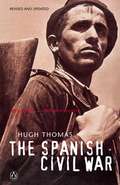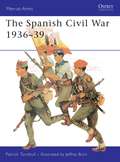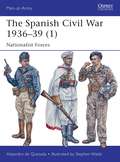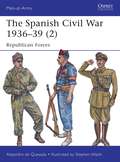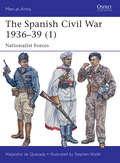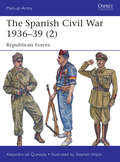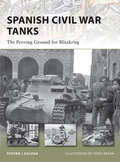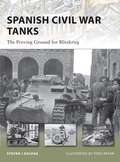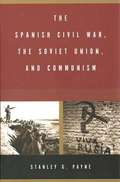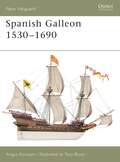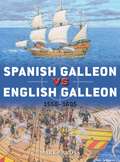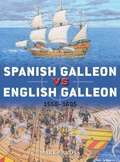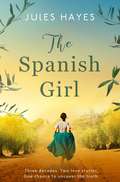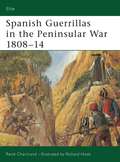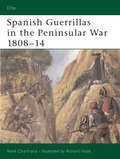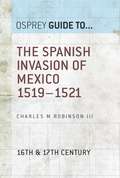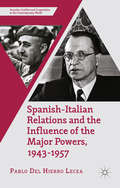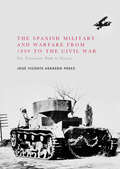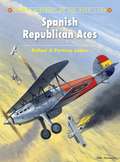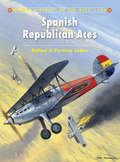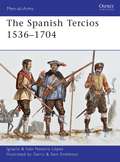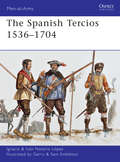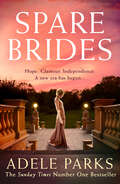- Table View
- List View
The Spanish Civil War: An Eyewitness Account Of The Spanish Civil War (Pelican Ser.)
by Hugh ThomasThough more than half a century has passed since the Spaish Civil War began in 1936, it is still the subject of intense controversy. What was it that roused left wing sympathisers from all over the world to fight for a cause for which their governments would not give active support? In his famous history, Hugh Thomas presents an objective analysis of a conflict - where fascism and democracy, communism and Christianity, centralism and regionalism were all at stake - and which was a much an international civil war as a Spanish one.
The Spanish Civil War 1936–39 (Men-at-Arms #74)
by Jeffrey Burn Patrick TurnbullBy the spring of 1936 an armed clash was imminent between the forces of Spain's extreme Left and extreme Right. Viewed largely as a confrontation between democracy and fascism, the resulting civil war proved to be of enormous international significance. Nazi Germany and Fascist Italy intervened to assist General Franco, while the Soviet Union came to the aid of the Republican forces. This book explains the background to the war and charts the course of the nearly three-year long conflict through to General Franco's victory. Photographs and colour plates illustrate the uniforms and equipment of the Republican and Nationalist armies.
The Spanish Civil War 1936–39 (Men-at-Arms #74)
by Patrick TurnbullBy the spring of 1936 an armed clash was imminent between the forces of Spain's extreme Left and extreme Right. Viewed largely as a confrontation between democracy and fascism, the resulting civil war proved to be of enormous international significance. Nazi Germany and Fascist Italy intervened to assist General Franco, while the Soviet Union came to the aid of the Republican forces. This book explains the background to the war and charts the course of the nearly three-year long conflict through to General Franco's victory. Photographs and colour plates illustrate the uniforms and equipment of the Republican and Nationalist armies.
The Spanish Civil War 1936–39: Nationalist Forces (Men-at-Arms)
by Stephen Walsh Alejandro De QuesadaThe Spanish Civil War, 1936–39, was the curtain-raiser to World War II, and the major international event of the 1930s. It was the first great clash of 20th-century ideologies, between the rebel Nationalist army led by General Franco (right-wing, and aided by Nazi Germany and Fascist Italy), and the Republican army of the government (left-wing, and aided by the Communist Soviet Union and many volunteers from liberal democracies). Three years of widespread campaigns involved the most modern weapons available. The war was fought ruthlessly by both sides, and when the Nationalists secured victory they installed a dictatorship that lasted until November 1975 – the last such regime in Western Europe. Featuring specially commissioned full-color artwork, this first part of a two-part study depicts the fighting men of the Nationalist forces that strove to take control of Spain alongside their German and Italian allies.
The Spanish Civil War 1936–39: Republican Forces (Men-at-Arms #498)
by Stephen Walsh Alejandro De QuesadaThe Spanish Civil War was the curtainraiser to World War II and involved a complex collection of forces, particularly on the Republican side. This title illustrates how diverse the Republican forces were, drawn from loyal elements of the Spanish army that rejected the appeal of the rebel generals, a wide range of volunteer regional units and political militias, and supported by volunteers from many other countries, including Great Britain, France and Germany, in units known as the International Brigades. The wide range of equipment and uniforms worn by these troops is revealed, as is, the organization of militias into conventional brigades and divisions. Featuring specially commissioned full-colour artwork, this second part of a two-part study depicts the fighting men of the Republican forces and examples of their foreign comrades.
The Spanish Civil War 1936–39: Nationalist Forces (Men-at-Arms #495)
by Stephen Walsh Alejandro De QuesadaThe Spanish Civil War, 1936–39, was the curtain-raiser to World War II, and the major international event of the 1930s. It was the first great clash of 20th-century ideologies, between the rebel Nationalist army led by General Franco (right-wing, and aided by Nazi Germany and Fascist Italy), and the Republican army of the government (left-wing, and aided by the Communist Soviet Union and many volunteers from liberal democracies). Three years of widespread campaigns involved the most modern weapons available. The war was fought ruthlessly by both sides, and when the Nationalists secured victory they installed a dictatorship that lasted until November 1975 – the last such regime in Western Europe. Featuring specially commissioned full-color artwork, this first part of a two-part study depicts the fighting men of the Nationalist forces that strove to take control of Spain alongside their German and Italian allies.
The Spanish Civil War 1936–39: Republican Forces (Men-at-Arms #498)
by Stephen Walsh Alejandro De QuesadaThe Spanish Civil War was the curtainraiser to World War II and involved a complex collection of forces, particularly on the Republican side. This title illustrates how diverse the Republican forces were, drawn from loyal elements of the Spanish army that rejected the appeal of the rebel generals, a wide range of volunteer regional units and political militias, and supported by volunteers from many other countries, including Great Britain, France and Germany, in units known as the International Brigades. The wide range of equipment and uniforms worn by these troops is revealed, as is, the organization of militias into conventional brigades and divisions. Featuring specially commissioned full-colour artwork, this second part of a two-part study depicts the fighting men of the Republican forces and examples of their foreign comrades.
Spanish Civil War Tanks: The Proving Ground for Blitzkrieg (New Vanguard #170)
by Steven J. ZalogaThe tanks used during the Spanish Civil War are not often examined in any great detail, and are often labeled as little more than test vehicles in a convenient proving ground before World War II. But, with groundbreaking research, armor expert Steven J Zaloga has taken a fresh look at the tanks deployed in Spain, examining how future tanks and armored tactics were shaped and honed by the crews' experiences, and how Germany was able to benefit from these lessons while their Soviet opponents were not. Based on recently uncovered records of Soviet tankers in Spain and rare archival accounts, this book describes the various tanks deployed in Spain, including the PzKpfw I and the T-26.
Spanish Civil War Tanks: The Proving Ground for Blitzkrieg (New Vanguard)
by Steven J. Zaloga Tony BryanThe tanks used during the Spanish Civil War are not often examined in any great detail, and are often labeled as little more than test vehicles in a convenient proving ground before World War II. But, with groundbreaking research, armor expert Steven J Zaloga has taken a fresh look at the tanks deployed in Spain, examining how future tanks and armored tactics were shaped and honed by the crews' experiences, and how Germany was able to benefit from these lessons while their Soviet opponents were not. Based on recently uncovered records of Soviet tankers in Spain and rare archival accounts, this book describes the various tanks deployed in Spain, including the PzKpfw I and the T-26.
The Spanish Civil War, the Soviet Union, and Communism (PDF)
by Stanley PayneIn this compelling book Stanley Payne offers the first comprehensive narrative of Soviet and Communist intervention in the revolution and civil war in Spain. He documents in unprecedented detail Soviet strategies, Comintern activities, and the role of the Communist party in Spain from the early 1930s to the end of the civil war in 1939. Drawing on a very broad range of Soviet and Spanish primary sources, including many only recently available, Payne changes our understanding of Soviet and Communist intentions in Spain, of Stalin's decision to intervene in the Spanish war, of the widely accepted characterisation of the conflict as the struggle of fascism against democracy, and of the claim that Spain's war constituted the opening round of World War II. The author arrives at a new view of the Spanish Civil War and concludes not only that the Democratic Republic had many undemocratic components but also that the position of the Communist party was by no means counterrevolutionary.
Spanish Galleon 1530–1690 (New Vanguard)
by Angus KonstamDuring the middle decade of the 16th century a new type of sailing vessel emerged, designed to carry the wealth of the Americas to Spain. This was the galleon, and over the next century these vessels would serve Spain well as treasure ships and warships, becoming a symbol of Spanish power and wealth during the period. The development and construction of the Spanish galleon are discussed in this book, and the ordnance and crewing needed to produce and maintain these stately vessels is covered. The author also examines the role of the galleon as a treasure ship, and describes how these ships were manned and fought in action.
Spanish Galleon vs English Galleon: 1550–1605 (Duel)
by Mark LardasBetween 1550–1600, Europe witnessed a rapid evolution in the art of ship design which enabled safer and more efficient transatlantic travel. This was the pinnacle of the Age of Discovery and Exploration for the European powers, in which the galleon played a crucial role. Galleons were both the main vessels in maritime commerce and the principal warships used by the opposing fleets throughout the Age of Exploration. This period also saw a large amount of naval combat, much of it between individual ships belonging to the competing powers of England and Spain as they sought to control and exploit the rich mineral, material, agricultural and human resources of the New World. The conflict between the English Sea Dogs and the Spanish Adventurers has been a source of fascination for over four centuries. This exciting addition to the Duel series explores how the galleons used by Spain and England were built and armed, and examines the effectiveness of the cannon they used. It also compares how they were sailed and manoeuvred, showing the strengths and weaknesses of each design, and explaining how these played out in several of their most prominent battles, including the Battle of San Juan de Ulúa, the fight between the Golden Hind and the Nuestra Señora de la Concepción, an action from the Spanish Armada, and the last fight of the Revenge.
Spanish Galleon vs English Galleon: 1550–1605 (Duel #106)
by Mark LardasBetween 1550–1600, Europe witnessed a rapid evolution in the art of ship design which enabled safer and more efficient transatlantic travel. This was the pinnacle of the Age of Discovery and Exploration for the European powers, in which the galleon played a crucial role. Galleons were both the main vessels in maritime commerce and the principal warships used by the opposing fleets throughout the Age of Exploration. This period also saw a large amount of naval combat, much of it between individual ships belonging to the competing powers of England and Spain as they sought to control and exploit the rich mineral, material, agricultural and human resources of the New World. The conflict between the English Sea Dogs and the Spanish Adventurers has been a source of fascination for over four centuries. This exciting addition to the Duel series explores how the galleons used by Spain and England were built and armed, and examines the effectiveness of the cannon they used. It also compares how they were sailed and manoeuvred, showing the strengths and weaknesses of each design, and explaining how these played out in several of their most prominent battles, including the Battle of San Juan de Ulúa, the fight between the Golden Hind and the Nuestra Señora de la Concepción, an action from the Spanish Armada, and the last fight of the Revenge.
The Spanish Girl: A completely gripping and heartbreaking historical novel
by Jules Hayes'A splendid story of heartbreaking consequences and ambition during the Spanish Civil War... A recommended read' Glynis Peters, bestselling author of The Secret Orphan***A country torn apart by war.Two love stories divided by decades.One chance to discover the truth... Feisty journalist Isabella has never known the truth about her family. Escaping from a dangerous assignment in the turbulent Basque country, she finds her world turned upside down, firstly by her irresistible attraction to the mysterious Rafael, and then by a new clue to her own past. As she begins to unravel the tangled story of her identity, Isabella uncovers a story of passion, betrayal and loss that reaches back to the dark days of Spain's civil war - when a passionate Spanish girl risked everything for her country, and for the young British rebel who captured her heart. But can Isabella trust the man she's fallen in love with? Or are some wartime secrets better left undisturbed...? Heartbreaking, gripping historical fiction about the tragedy of war, and the redemption of love. Perfect for fans of Angela Petch's The Tuscan Secret and Kathryn Hughes' The Letter. ***Praise for The Spanish Girl:'An outstanding read... Epic, personal, intimate and beautifully written' Lizzie Page, author of The Forgotten Girls'A compelling tale of friendship, love and loss. Impeccably researched, the story is full of surprises' Rhiannon Ward, author of The Quickening'A fabulous read of love, loss, loyalty and bravery set against the fascinating backdrop of the Spanish War. I was engrossed from the start and a must read for fans of dual timeline women's fiction' Suzanne Fortin, author of The Forgotten Life of Arthur Pettinger
Spanish Guerrillas in the Peninsular War 1808–14 (Elite)
by Richard Hook René ChartrandConstant Spanish guerrilla activity so drained the resources and diverted the attention of the French military that Wellington was able to advance against and overcome a numerically superior enemy. So many French soldiers were being used to counter the guerrillas and the threat that they posed that less than a third of the French army could be tasked with confronting Wellington. This book brings to life, for the first time, the formation, tactics and experiences of the Spanish guerrilla forces that fought Napoleon's army. Using much previously unpublished material, it offers a vivid description of the guerrilla and his lifestyle.
Spanish Guerrillas in the Peninsular War 1808–14 (Elite #108)
by Richard Hook René ChartrandConstant Spanish guerrilla activity so drained the resources and diverted the attention of the French military that Wellington was able to advance against and overcome a numerically superior enemy. So many French soldiers were being used to counter the guerrillas and the threat that they posed that less than a third of the French army could be tasked with confronting Wellington. This book brings to life, for the first time, the formation, tactics and experiences of the Spanish guerrilla forces that fought Napoleon's army. Using much previously unpublished material, it offers a vivid description of the guerrilla and his lifestyle.
The Spanish Invasion of Mexico 1519–1521 (Guide to... #60)
by Charles M. Robinson IIIThe Spanish conquest of Mexico was the most remarkable military expedition in history, and in achieving it, Hernan Cortes proved himself as one of the greatest generals of all time. This book explains the background of the Aztec Empire and of the Spanish presence in Mexico. It describes the lives of the Aztecs in their glittering capital and of the Europeans who learned to adapt and survive in an alien and often dangerous world. The invasion was a war between civilizations, pitting the fatalism and obsessive ritual of the Aztecs against soldiers fighting for riches, their lives, and eventually their souls.
Spanish-Italian Relations and the Influence of the Major Powers, 1943-1957 (Security, Conflict and Cooperation in the Contemporary World)
by Pablo Del Hierro LeceaSpanish-Italian Relations and the Influence of the Major Powers examines complex relations between Spain and Italy, beginning in 1943 and continuing until 1957, contending that the relationship cannot be examined in isolation and must be understood in its broader context.
The Spanish Military and Warfare from 1899 to the Civil War: The Uncertain Path to Victory
by José Vicente Herrero PérezThis book explores the attitudes of the Spanish army officer corps towards the evolution of warfare during the early decades of the twentieth century, and their influence on the armies of the Spanish Civil War. It examines how the Spanish military coped with technological innovations such as the machine gun and the tank, how it adapted the army´s battlefield doctrine to changes in warfare before the Civil War, and the influence of this doctrine on the outcome of the conflict. Of the different armed forces that fought in the Spanish Civil War, it is paradoxically the Spanish army that remains most forgotten - especially its military doctrine. Scholarship on the Spanish military in this period focuses on its politics, ideology and institutional reforms, touching upon 'hard' professional issues only superficially, if at all. Based on original research and using largely unstudied Spanish primary sources, this book fills a major scholarly gap in the history of the Spanish army and the Spanish Civil War.
Spanish Republican Aces (Aircraft of the Aces)
by Rafael A López Permuy Julio López CaeiroAt the start of the Spanish Civil War, most young fighter pilot officers joined the rebels, while the high ranking officers, grupo or escuadrilla commanders, and the NCOs, sergeants and corporals remained loyal to the government. Mostly flying the obsolete Nieuport Ni.52s these loyalists were soon outpaced by the more modern Fiat CR.32s and Heinkel He 51s. However, at this early stage of the war, there were several Republican airmen who became aces and famous in the process, despite the small numbers of enemy aircraft shot down. Widely speaking, the Republican military aviation did not keep an exhaustive record of individual shooting claims. However, sufficient documentation exists to make a reasonable assumption as to which pilots fall into the ace category. This volume details the exploits of those pilots, complementing previous works in the Osprey Aircraft of the Aces series on Nationalist CR.32 Aces and Polikarpov I-15, I-16 and I-152 Aces.
Spanish Republican Aces (Aircraft of the Aces #106)
by Rafael A López Permuy Julio López CaeiroAt the start of the Spanish Civil War, most young fighter pilot officers joined the rebels, while the high ranking officers, grupo or escuadrilla commanders, and the NCOs, sergeants and corporals remained loyal to the government. Mostly flying the obsolete Nieuport Ni.52s these loyalists were soon outpaced by the more modern Fiat CR.32s and Heinkel He 51s. However, at this early stage of the war, there were several Republican airmen who became aces and famous in the process, despite the small numbers of enemy aircraft shot down. Widely speaking, the Republican military aviation did not keep an exhaustive record of individual shooting claims. However, sufficient documentation exists to make a reasonable assumption as to which pilots fall into the ace category. This volume details the exploits of those pilots, complementing previous works in the Osprey Aircraft of the Aces series on Nationalist CR.32 Aces and Polikarpov I-15, I-16 and I-152 Aces.
The Spanish Second Republic Revisited: From Democratic Hopes to Civil War (1931-1936) (Liverpool Studies in Spanish History)
by Manuel Álvarez Tardío Fernando ReguilloThe Spanish Civil War is one of the most studied events in modern European history. Its origins, that is to say the politics of the Second Republic (1931-1936), have been much debated. The republican period has been much idealised and in particular the myth of Spanish democracy beset by fascism, of which Franco was its leading figure, has been much cultivated. But was this really the case? Recently historians of the Republic have proposed a new and non-ideological perspective on the 1930s. Spain's path was at once different yet in many ways similar to that of Europe during the inter-war period. This book brings together leading and innovative specialists to analyse the main obstacles to the consolidation of democracy in Spain and to debate the principal stereotypes of the traditional historiography of both left and right. The issues addressed include: the breakdown of democracy; whether the CEDA was an opportunity or a threat; the centrist appeal under the Republic; how the elections were viewed and conducted; the transformation of fascism; new revelations about the Communist party; the politics of exclusion at the local level; the perceived necessity for repression; new perspectives on the Civil Guard; the role of intellectuals in the Republic; and revisionism and sectarian history. The book offers a new and dynamic vision of why Spanish democracy failed to consolidate itself and why it finally fell into the terror of civil war. Essential reading for all those interested in modern European history.
The Spanish Tercios 1536–1704 (Men-at-Arms)
by Gerry Embleton Ignacio J.N. LópezA mixed infantry formation made up of about 3,000 men armed with pikes, swords and handguns, the innovative and influential tercio or 'Spanish square' was the basic combat unit of the armies of Spain throughout much of the 16th and 17th centuries. Arguably the first permanent tactical formation seen in Europe since the Roman cohort, the tercio was the forerunner of modern formations such as the battalion and regiment. The variety of different weapons fielded in the tercio meant the Spanish infantry could resist opposing cavalry forces while overcoming every kind of enemy infantry deployed against them. Featuring full-colour artwork and photographs of rare items held at the Spanish Army Museum, this study covers the whole period during which the tercios were active, opening with the third Italian war between the forces of France and the Holy Roman Emperor and concluding with the final transformation of the Spanish tercios into regiments in 1704.
The Spanish Tercios 1536–1704 (Men-at-Arms #481)
by Gerry Embleton Ignacio J.N. LópezA mixed infantry formation made up of about 3,000 men armed with pikes, swords and handguns, the innovative and influential tercio or 'Spanish square' was the basic combat unit of the armies of Spain throughout much of the 16th and 17th centuries. Arguably the first permanent tactical formation seen in Europe since the Roman cohort, the tercio was the forerunner of modern formations such as the battalion and regiment. The variety of different weapons fielded in the tercio meant the Spanish infantry could resist opposing cavalry forces while overcoming every kind of enemy infantry deployed against them. Featuring full-colour artwork and photographs of rare items held at the Spanish Army Museum, this study covers the whole period during which the tercios were active, opening with the third Italian war between the forces of France and the Holy Roman Emperor and concluding with the final transformation of the Spanish tercios into regiments in 1704.
Spare Brides
by null Adele ParksHope. Glamour. Independence. A new era has begun… ‘A wonderfully absorbing tale of friendship, rich in period detail’ Stylist With the Great War behind them, four friends are ready to live again. Lydia, a society beauty, has everything – wealth, status and a husband who survived the War. All she has to do now is provide an heir. Widowed Sarah cares for her wounded brother, certain that no one will ever replace her brave husband. Younger sister Beatrice finds it hard to shine, especially when there are so few men left to shine for… And independent Ava – who can light any room – is determined to seize the freedom of being a single woman. But when these four meet the irresistible war hero Sergeant Major Edgar Trent, everything changes… Spare Brides is a glorious novel about love, loss, change and chances from the Number One bestselling author Adele Parks. Praise for Spare Brides: ‘A resounding success … a triumph’ Daily Mail ‘A touching novel’ Daily Express ‘You’ll love the drama, the gorgeous dresses, grand houses and in particular, the handsome but damaged love interest’ Good Housekeeping ‘This is the first historical novel from bestselling author Adele Parks and it’s a powerful read’ Closer ‘The great author’s first historical novel and it’s a total smash’ Heat ‘A wonderful novel about a group of women struggling to deal with life after World War One… a heady cocktail of love, class and beaded frocks. Her most accomplished novel yet’ Daisy Goodwin ‘A wonderfully absorbing tale of friendship, rich in period detail’ Stylist ‘A fantastic read’ Fabulous
